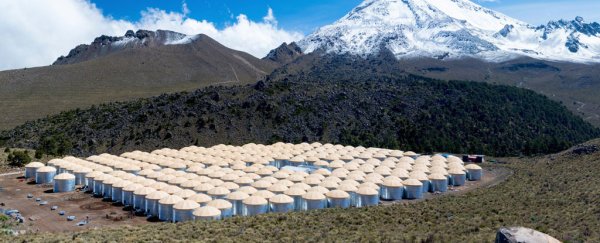On the flanks of the Sierra Negra volcano in Central Mexico, nearly 14,000 feet (4,267 metres) above sea level, there is a giant field of water tanks. Three hundred water tanks, to be exact, occupying a space that's roughly the size of three football fields.
Collectively, this massive array is known as the High Altitude Cherenkov Gamma Ray Observatory (HAWC), and it's helping scientists measure high energy particles from outer space called cosmic rays that are racing toward us at nearly the speed of light.
Cosmic rays are often called space messengers. That's because they carry information from distant parts of the cosmos, up to billions of light-years away. Just like astronomers use different wavelengths of light to understand different aspects of the Universe, scientists can study different properties of cosmic rays – like their velocity, trajectory, radiation, mass, and energy – to learn more about our Universe, including its structure, composition, and the processes happening within it.
Using cosmic rays, scientists can try to answer questions about our galaxy and the Universe that they wouldn't be able to using visual clues alone.
In addition to being messengers, cosmic rays are a form of high energy radiation and can be damaging to the human body, which is why it's a good thing that Earth's atmosphere blocks most of them from ever reaching us at the surface.
But astronauts in space who are unsheltered by the atmosphere are not protected from this radiation. Understanding how and when cosmic rays are produced can also help us protect them.
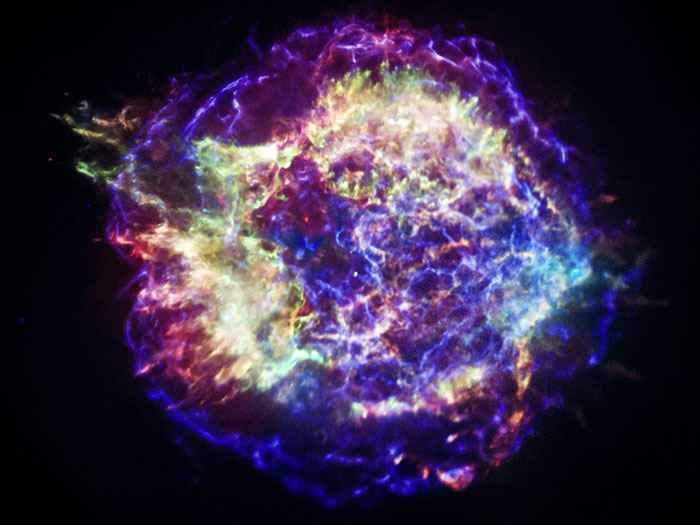 HAWC will allow scientists to study some of the most violent processes in the Universe. Credit: NASA/CXC/SAO
HAWC will allow scientists to study some of the most violent processes in the Universe. Credit: NASA/CXC/SAO
The most sensitive map ever made
Cosmic rays were originally discovered in 1912 by Austrian physicist Victor Hess, but scientists still aren't sure where they come from. Some cosmic rays have such high energies that scientists believe they might have been created by some of the most violent processes in the Universe – supermassive black holes, rapidly spinning super dense stars, remnants of exploding stars.
By figuring out exactly where these cosmic rays are originating, scientists will be able to probe these violent processes and get a better understanding of the Universe.
That's why scientists at HAWC, a collaboration between national laboratories and universities in Mexico and the United States, are working together to get a closer look. On April 18, after a little over a year of collecting data, HAWC released the highest energy and most sensitive map ever made of the sky.
"We spent four years working in the high mountains in Mexico, taking this green hillside and turning it into a laboratory," Jordan Goodman, the US spokesperson and principal investigator for HAWC, said. "Now we're getting to the fun part of actually doing the science – making the highest energy map that anyone's ever made and seeing things no one's ever seen before."
But cosmic rays are charged particles, which means their paths in space are bent by magnetic fields. This makes it hard to retrace their steps to figure out what which forces catapulted them towards us. In order to get to the bottom of this mystery, scientists are studying the highest energy light particles out there, gamma rays.
The same violent processes that produce cosmic rays can also radiate gamma rays. And because gamma rays are light particles, or photons, they travel in straight lines through space unaffected by magnetic fields. By tracing these gamma rays back to their sources, scientists might link their path to the mysterious cosmic rays.
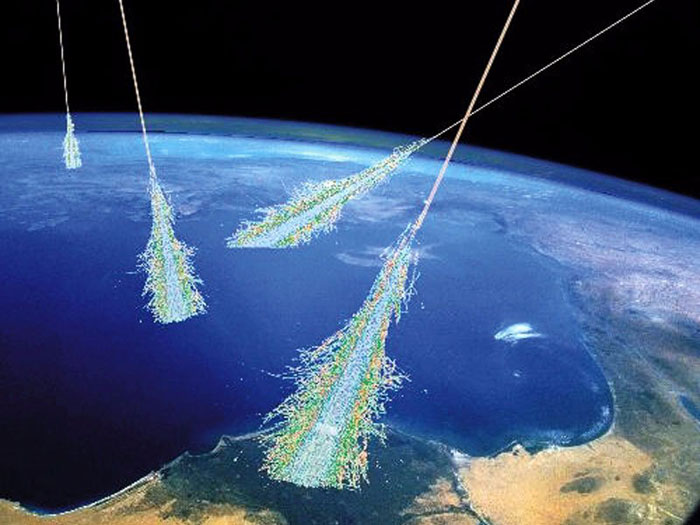 This very second, billions of cosmic rays are smashing into our atmosphere. Credit: NASA
This very second, billions of cosmic rays are smashing into our atmosphere. Credit: NASA
So what's with the water tanks?
Both cosmic rays and gamma rays speed into our atmosphere, smashing into other particles and creating a cascade of secondary particles called an air shower. As the air shower descends towards the ground at nearly the speed of light, the particles spread out, multiplying as they smash into other particles. They then form a particle pancake that contains billions of particles that can spread up to 10 miles (16 kilometres) wide.
This is where all those giant water tanks come in. Each of the tanks holds 50,000 gallons (189,270 litres) of purified water – an amount that required 3,900 tanker trucks driving up the mountain to fill them, Goodman told Business Insider.
When the high-energy particle pancake (the one that's travelling at nearly the speed of light) smacks into the water, the individual particles produce blue cones of light called Cherenkov radiation. A team of four extremely sensitive light detectors fixed to the bottom of the tanks picks up these flashes of light.
Because the vast majority of particles hitting the detectors are a result of the bent cosmic rays, scientists need to filter out them by the different footprints they produce. Then, by measuring nanosecond-size differences in the time it takes the particles from the gamma ray showers to arrive in each of the different tanks, scientists can reconstruct the direction they came from. The result is their high energy Universe map.
"We are only now pinpointing what the actual sources of cosmic rays are," University of New Mexico research assistant professor and HAWC collaborator Robert Lauer told Business Insider. "Now with this map we can really check individual objects in our galaxy and beyond and say this which sources are producing these particles."
Seven times more powerful than the most powerful particle smasher on the planet
So just how high-energy is this map? Well, most of the particles HAWC detects are just about the same energy as particles produced in the Large Hadron Collider, the most powerful particle collider on the planet. But some of them can be up to seven times more energetic, much more powerful than anything we can create here on Earth. And the longer HAWC runs, the higher the energies it will pick up.
What makes HAWC unique is that unlike other gamma ray detectors, which can only operate on dark, moonless nights focusing on just a small section of the sky, HAWC is a detector that operates around the clock and looks at the entire overhead sky all at once.
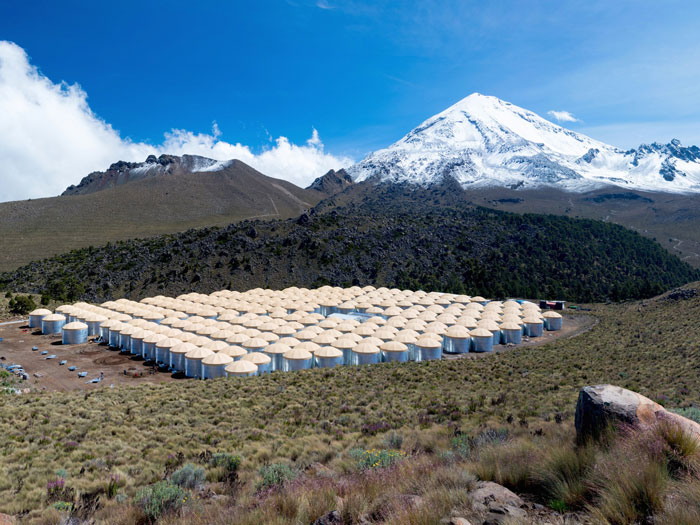 HAWC is a massive array of water detectors located near the Sierra Negra volcano in Mexico. Credit: Jordanagoodman
HAWC is a massive array of water detectors located near the Sierra Negra volcano in Mexico. Credit: Jordanagoodman
Twenty thousand air shower particles per second hit our detector, Brenda Dingus, the principal investigator of the US Department of Energy funding for HAWC and research fellow at Los Alamos National Laboratory told New Scientist. This produces about 2 terabytes of data every day and nearly a petabyte per year.
Since the birth of gamma ray astronomy in the '60s, NASA Marshall Spaceflight Centre and HAWC collaborator Michelle Hui told Business Insider, they've gone from having only a handful of sources to having over a hundred. In just its first year of data, HAWC picked up 40 different sources of gamma rays, many of which had never been seen before.
Black holes and exploding stars
One of these sources is located 400 million light-years away in a galaxy called Markarian 501. On 7 April 2016 HAWC detected a flare of gamma rays coming from Markarian 501 that lasted a little over a day before disappearing. Scientists believe that a flickering supermassive black hole living in the centre of the galaxy might have produced this flare. If HAWC hadn't been running day and night focusing on the entire sky above, it would have missed it.
"We can see events that occurred 400 million years ago and still follow all of these interesting things that happened very rapidly," Lauer said. "It's a completely different way to look at the most extreme objects in Universe – in our own galaxy and others."
Scientists found another source in the remnants of a supernova in our own galaxy. When a massive star dies, collapsing under its own gravity, it explodes into a supernova. The explosion sometimes leaves behind a pulsar, which is a super dense star (imagine the mass of our sun compressed into something the size of Washington, DC) that can spin more than 50 times per second.
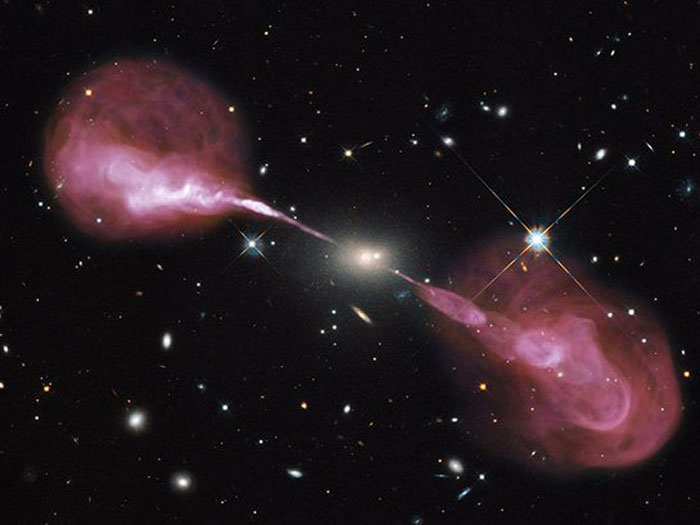 Supermassive black holes are one candidate for what might accelerate cosmic rays to such high energies. Credit: NASA, ESA, S. Baum and C. O'Dea (RIT), R. Perley and W. Cotton (NRAO/AUI/NSF), and the Hubble Heritage Team (STScI/AURA)
Supermassive black holes are one candidate for what might accelerate cosmic rays to such high energies. Credit: NASA, ESA, S. Baum and C. O'Dea (RIT), R. Perley and W. Cotton (NRAO/AUI/NSF), and the Hubble Heritage Team (STScI/AURA)
This spinning star generates intense magnetic fields, which scientists believe might produce a wind of high energy particles. As shockwaves spread through the shell of stellar material surrounding the pulsar that was left behind by the supernova explosion, the particles are accelerated to even higher energies and can emit gamma rays, which is what HAWC picked up.
The Fermi Telescope, a space observatory orbiting in space, had already been investigating the pulsar itself but HAWC has a unique perspective on the way the cosmic rays interact with the supernova guts surrounding the pulsar.
The next big project for HAWC, Hui said, is to compare the data with other experiments and look at how their findings overlap with other findings in the community to try to understand the bigger picture. Scientists at HAWC hope to work with the community to gain insight into new physics and possibly even put the 100-year-old mystery of cosmic rays to rest.
"We've been looking at the sky for a long time," Hui said. "But now we have this new instrument up and we're still seeing new things that we hadn't seen before. Just to figure out what these objects are is exciting."
This article was originally published by Business Insider.
More from Business Insider:
